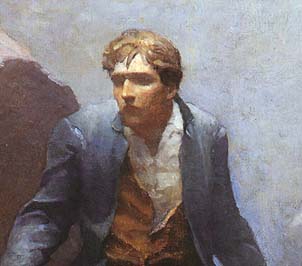
He’s still got those caterpillar eyebrows, bug eyes, top tuft, bulbous nose and wide grin. But when we see all his details and textures, he has an altogether different charm—or creepiness.
“Untooning” has been a hot internet meme over the last few years, and it raises all sorts of questions about verisimilitude.

A face that has been abstracted can be just as real to us emotionally, maybe more so. Think of African masks. Character designers at CGI animation studios are also very conscious of dialing down the realism on human characters. Too much realism can drop us into the uncanny valley.
I think the same thing is true of storytelling paintings, such as this illustration by N.C. Wyeth from Kidnapped. It’s more of a mental image he was striving for. By not showing his eyes, Wyeth makes David Balfour seem more lost in the fog.
----------
Bert from BoingBoing
See Mario, Charlie Brown, and other Untooned characters at Huffington Post
Related GJ post about camera face detection







10 comments:
I think I'm going to have nightmares tonight after seeing burt in this new light (or is that darkenss?). You could make a whole horror movie based on this concept. Move over chuckie, step aside jason, here comes BURT!
The cartoon Bert is poking his tongue out at us.
In my view the realistic Bert's "wide grin" makes him look too serious.
Therefore it's an inaccurate rendition, in my view.
Interesting phenomenon, this "uncanny valley".
Unnerving, but funny nonetheless. Maybe a little too "Zippy the Pinhead" - the head's not as ovoid as Bert's, methinks.
Scott McCloud discusses the topic of abstraction versus realism in character design in the context of comics in his outstanding book Understanding Comics (see the ToC at Google Books). He talks about how as a face becomes more abstract it can take on a purely symbolic meaning, to point where a smiley face implies the concept of happiness and the reader can apply those concepts to herself instead of seeing the face as a character or representation on the page. Definitely worth a read.
It DOES look like Zippy the Pinhead. I agree with you, James, about abstraction sometimes conveying more than verisimilitude. (Of course, I come from a fine art background, and in academic fine art circles, there is often a strong bias against realism of any kind--even hyperrealism. Not that I agree with that bias!)
My first thought was of Scott McCloud too -- How the abstract cartoon face allows us to easily identify and empathize, because it corresponds with our abstracted mind picture of our own facial features. Our sense is not a photo realistic image of our face, but a simplified, "general placement" of features as they convey emotion.
As you move towards realism, the image represents "another". Combine super realistic aspects with surreal aspects (say inorganic movement or behavior) and the another becomes "other".
I always prefer strong design over mushy realism...
Let's just put it this way: I'm glad Bert doesn't live on my street corner.
Enough said.
But this is a very interesting topic, and I've always admired and wondered about N.C. Wyeth's decision to mute the eyes in many of his paintings. But in others they are certainly pronounced. I love his painting style so much...
Mr. Gurney- Love your blog and just finished 'Imaginative Realism' -read it cover to cover yesterday. I'm returning to illustration after a 20 year hiatus and your book is the best I've read on the subject. Thank you for sharing so much of your experience and knowledge with us.
Post a Comment